
A rose is either a woody perennial flowering plant of the genus Rosa, in the family Rosaceae, or the flower it bears. There are over three hundred species and tens of thousands of cultivars. They form a group of plants that can be erect shrubs, climbing, or trailing, with stems that are often armed with sharp prickles. Their flowers vary in size and shape and are usually large and showy, in colours ranging from white through yellows and reds. Most species are native to Asia, with smaller numbers native to Europe, North America, and Northwest Africa. Species, cultivars and hybrids are all widely grown for their beauty and often are fragrant. Roses have acquired cultural significance in many societies. Rose plants range in size from compact, miniature roses to climbers that can reach seven meters in height. Different species hybridize easily, and this has been used in the development of the wide range of garden roses.

Malus is a genus of about 32–57 species of small deciduous trees or shrubs in the family Rosaceae, including the domesticated orchard apple, crab apples and wild apples.

Rosa rugosa is a species of rose native to eastern Asia, in northeastern China, Japan, Korea and southeastern Siberia, where it grows on beach coasts, often on sand dunes. It is naturalized in much of Europe and parts of the United States and Canada. It should not be confused with Rosa multiflora, which is also known as "Japanese rose". The Latin word "rugosa" means "wrinkled", referring to the wrinkled leaves. Often used as an ornamental plant, it has become invasive in parts of Europe, North America and South America.

Rosa multiflora is a species of rose known commonly as multiflora rose, baby rose, Japanese rose, many-flowered rose, seven-sisters rose, Eijitsu rose and rambler rose. It is native to eastern Asia, in China, Japan, and Korea. It should not be confused with Rosa rugosa, which is also known as "Japanese rose", or with polyantha roses which are garden cultivars derived from hybrids of R. multiflora. It was introduced to North America, where it is regarded as an invasive species.

Koelreuteria paniculata is a species of flowering plant in the family Sapindaceae, native to China. Naturalized in Korea and Japan since at least the 1200s, it was introduced in Europe in 1747, and to America in 1763, and has become a popular landscape tree worldwide. Common names include goldenrain tree, pride of India, China tree, and the varnish tree.
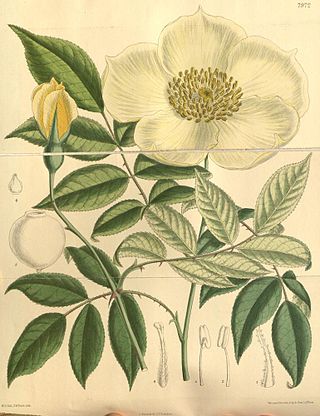
Rosa gigantea is a species of rose native to northeast India, northern Myanmar and southwest China (Yunnan) in the foothills of the Himalaya at 1000–1500 m altitude. It is sometimes considered to be a variety of Rosa odorata, as R. odorata var. gigantea.
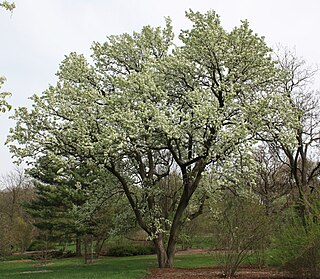
Pyrus calleryana, also known as the Callery pear or Bradford pear, is a species of pear tree native to China and Vietnam, in the family Rosaceae. It is most commonly known for its cultivar 'Bradford' and its offensive odor, widely planted throughout the United States and increasingly regarded as an invasive species.

Dasiphora fruticosa is a species of hardy deciduous flowering shrub in the family Rosaceae, native to the cool temperate and subarctic regions of the northern hemisphere, often growing at high altitudes in mountains. Dasiphora fruticosa is still widely referenced in the horticultural literature under its synonym Potentilla fruticosa. Common names include shrubby cinquefoil, golden hardhack, bush cinquefoil, shrubby five-finger, widdy, kuril tea and tundra rose.
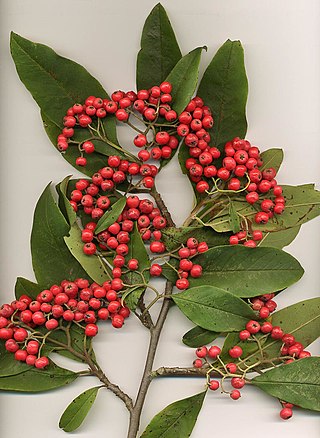
Cotoneaster is a genus of flowering plants in the rose family, Rosaceae, native to the Palaearctic region, with a strong concentration of diversity in the genus in the mountains of southwestern China and the Himalayas. They are related to hawthorns (Crataegus), firethorns (Pyracantha), photinias (Photinia), and rowans (Sorbus).

Magnolia wilsonii, or Wilson's magnolia, is a species of Magnolia native to China, in the provinces of western Guizhou, Sichuan and northern Yunnan, where it grows in the forest understory at altitudes of 1,900-3,000 m, rarely up to 3,300 m.

Photinia is a genus of about 30 species of small trees and large shrubs, but the taxonomy has recently varied greatly, with the genera Heteromeles, Stranvaesia and Aronia sometimes included in Photinia.

Magnolia dawsoniana, known as Dawson's magnolia, is a magnolia species native to the provinces of Sichuan and Yunnan in China, usually at altitudes of 1,400 to 2,500 m.

Juniperus squamata, the flaky juniper, or Himalayan juniper is a species of coniferous shrub in the cypress family Cupressaceae, native to the Himalayas and China.

Rosa sericea, the silky rose, is a species of flowering plant.
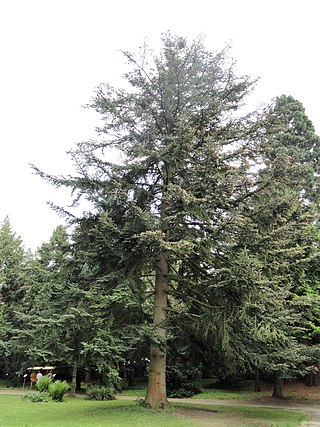
Abies chensiensis, the Shensi fir, is a fir native to Gansu, Hubei, Sichuan, Tibet, Yunnan in China, and Arunachal Pradesh in India. It was first described by Philippe Édouard Léon Van Tieghem in 1892.
Ligustrum pricei is a species of Ligustrum, native to China and Taiwan, where it occurs at 900–1700 m altitude.

Cercidiphyllum japonicum, known as the Katsura, is a species of flowering tree in the family Cercidiphyllaceae native to China and Japan. It is sometimes called caramel tree for the light caramel smell it emits during leaf fall. It is also sometimes called candyfloss tree because of the scent.

Rhododendron longipes is a rhododendron species native to Chongqing, eastern Guizhou, southwestern Sichuan, and northeastern Yunnan in China, where it grows at altitudes of 1,700–2,500 m (5,600–8,200 ft). It is a shrub or small tree that grows to 2–4 m (6.6–13.1 ft)in height, with leathery leaves that are elliptic or elliptic-lanceolate, and 5–13 cm (2.0–5.1 in) long by 1.5–3.5 cm (0.6–1.4 in) wide. Its flowers are rose-colored with dark red spots inside. It is placed in section Ponticum.
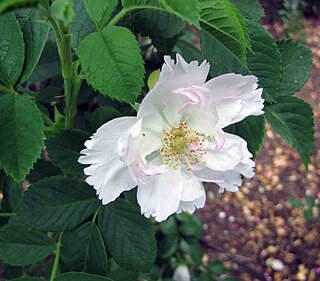
Rosa soulieana, or Soulié's rose, is a species of flowering plant in the family Rosaceae, native to China.





















